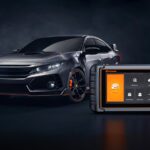As a seasoned auto repair expert and content creator for obd-de.com, I recently put the Actron CP9185 OBD2 auto scanner through its paces. Marketed as a versatile tool for both OBD2 and some OBD1 systems, it’s crucial to assess if this scanner lives up to the hype, especially in a market flooded with diagnostic tools. Here’s a comprehensive breakdown of my experience with the Actron CP9185.
Unboxing and First Impressions
The Actron CP9185 OBD2 scanner arrives in a practical soft case, accompanied by an instruction booklet, a CD, a main cable, a USB cable, and a short OBD2 (16-pin) adapter cable. Interestingly, my package was missing the CD, which is supposed to contain the full user manual and necessary PC connection software. This omission could be a minor inconvenience for some users, potentially requiring a software download from the manufacturer’s website. Aside from this, all components were in excellent condition.
Alt text: Actron CP9185 OBD2 Auto Scanner kit contents displayed including scanner, cables, case and manual, highlighting the components for a car diagnostic tool.
Purchased directly from Amazon for $175 (a price that seemed to be a limited-time deal), the standard retail price appears to be significantly higher, around $259 or even Actron’s direct price of $398. This price fluctuation is worth noting for potential buyers. The scanner itself features a power button, but the display backlight only activates when connected to an external 12V power source, either from the car’s OBD2 port or an external DC adapter, particularly necessary for OBD1 vehicles lacking power at the DLC.
Alt text: Actron CP9185 cable adapters showcasing OBD2 16-pin connector and OBD1 adapter cable, essential for diverse vehicle diagnostic compatibility.
OBD1 Performance: A Standout Feature
To evaluate the OBD1 capabilities, I acquired the CP9127 OBD1 adapter cables, which include a 12-pin adapter and a cigarette lighter power adapter. This is crucial because older OBD1 systems don’t supply power through the diagnostic link connector. For 1995 F-body cars, the standard 16-pin OBD2 cable is compatible. However, for 1994 models, the CP9127 adapter is necessary unless you’re prepared to create a custom adapter cable.
Testing on a range of OBD1 vehicles, including 1994/95 LT1, 1994/95 L34, and an 86 5.0L carbureted engine, the Actron CP9185 performed admirably. All vehicles connected without issue, providing access to at least three screens of live data, alongside current and historical Diagnostic Trouble Codes (DTCs). The field service feature, which grounds the field service pin on the DLC, functioned correctly with the OBD1 cable. It’s important to note that for 1995 OBD1 cars using the OBD2 cable, the field service mode may not function due to pin configuration changes related to later CAN signals.
Alt text: Actron CP9185 OBD1 scanner diagnosing a 1994 LT1 engine, displaying live data on the handheld device during automotive troubleshooting.
Alt text: Actron CP9185 screen showing real-time engine data from a 94 LT1, illustrating live diagnostic capabilities of the OBD1 scanner.
Alt text: Actron CP9185 OBD1 scanner interface displaying vehicle parameters for a 94 LT1, indicating detailed engine diagnostics.
Alt text: Actron CP9185 screen displaying engine readings on a 94 LT1 model during OBD1 diagnostics, useful for automotive analysis.
Alt text: Actron CP9185 OBD1 scanner gauges interface presenting live data for a 94 LT1, enhancing real-time vehicle monitoring.
Alt text: Actron CP9185 digital display showing detailed engine data for a 94 LT1, providing precise readings for automotive diagnostics.
Alt text: Actron CP9185 OBD1 displaying a real-time data stream for a 94 LT1, enabling dynamic monitoring of vehicle performance parameters.
Alt text: Actron CP9185 OBD1 scanner reading and displaying DTC trouble codes for a 94 LT1, crucial for diagnosing vehicle issues.
OBD2 Functionality: Less Impressive
Unfortunately, the OBD2 performance of the CP9185 is less compelling. In my tests, the OBD2 functions were no more advanced than what you’d find in a basic and significantly cheaper OBD2 code reader like the Autel Maxiscan MS310. This budget-friendly tool offers nearly identical OBD2 functionalities, making it a strong competitor to the CP9185 in this area. For comprehensive OBD2 diagnostics, software like OBDWiz, often bundled with inexpensive ELMScan-5 Compact adapters, provides a more feature-rich experience.
Limited Extra Features
The Actron CP9185 lacks support for ABS or SRS modules and actuator tests, limiting its capabilities for more in-depth diagnostics. Graphing capabilities are rudimentary, with low resolution and restricted to certain OBD2 parameters only. OBD1 parameters do not support graphing at all. Even the OBD2 graphs are flawed, lacking a pause function for detailed examination, despite the manual mentioning a “rewind” feature which I couldn’t locate.
Data logging is available for both OBD1 and OBD2, but the recording time is disappointingly short, sometimes under 20 seconds, and the data update rate is slow. PC connectivity is possible for data transfer, but it’s limited to exporting log data in text format.
Final Verdict
The Actron CP9185 OBD2 auto scanner shines primarily in its OBD1 capabilities. If your diagnostic needs include older OBD1 vehicles, the CP9185, especially when paired with the OBD1 adapter kit, is a valuable tool. However, for OBD2 diagnostics, its performance doesn’t justify its price point compared to more affordable and equally capable, or even more feature-rich, alternatives available on the market. Therefore, consider this scanner mainly if OBD1 compatibility is a priority.
